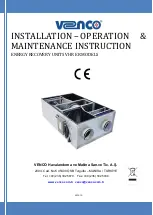
8.
Repairs
21
Hold the cables just under the slider block
between your thumb and forefinger and press
together with approx. 70 N of force.
Adjust using the bolts at the top.
OR:
Carry out 5 full cycles (up/down) with a vehicle
so that the cables have been correctly
stretched.
Remove the vehicle from the lift.
Raise the slider to the top position against the
mechanical stop.
Finally, tighten the bottom nuts on the threaded
cable ends, until the tension of both cables is
identical.
Carry out a cycle without a load, align the arms
with each other to see if they are at the same
level.
If necessary, adjust the cable tension.
If the slider blocks are at the same level, the
mechanical safety latches must engage at the
same time.
Carry out several cycles with a load, in doing so
make sure that the vehicle is centred on the
longitudinal axis of the lift.
If this is not the case, then carry out re-
adjustments.
Further instructions on adjusting the synchronisation
cables can be found in section 12.
7.9 Carry out a function test
WARNING
Risk of injury through function
failures.
If lift functions fail, shut down and lock the lift
immediately.
Immediately correct the failures and ensure
that the operation runs smoothly.
1. Check full functionality of the lift without load.
2. Check full functionality of the lift with load.
8.
Repairs
Repair work may only be carried out on
equipment that is switched off and locked by
trained and authorised specialists.
Refer to the safety regulations in chapter 7.2.
All repairs must be documented (
Form
“Unscheduled safety inspection“).
9.
Safety inspections
To guarantee the safety of the lift when in operation,
it is necessary to carry out safety inspections.
Safety inspections should be carried out in the
following cases:
Initial installation
: Use the form “Initial safety
inspection before commissioning“.
Annual
: Use the form “Annual safety
inspection“.
Unscheduled safety inspection
:
After any design modification to lift parts. Use
the form “Unscheduled safety inspection“.
Safety inspections may only be carried out by
competent persons or certified experts.
10.
Transport, storage
10.1 Storage
Lift components must always be kept in a dry place
(no corrosion protection).
Recommended storage
conditions
Ambient temperature:
-5 ... +50
Relative humidity,
30 % ... 95 %
without condensation, at 20 °C
The manufacturer provides no warranty for
corrosion damage caused by incorrect
storage.
10.2 Transport
DANGER
Danger of crushing and shearing of
limbs when unloading.
Caused by collapsing or slipping
loads.
i
Summary of Contents for SGL35M
Page 2: ......
Page 39: ...Diagrams spare parts lists 37 Electrical Circuit Diagram single phase...
Page 40: ...Diagrams spare parts lists 38 Electrical Circuit Diagram 3 phase...
Page 42: ...40...
Page 44: ...Diagrams spare parts lists 42 8 9 2 3 5 4 15 1 14 17 7 18 6 16 11 12 10 26 13 11...
Page 45: ...Figure 2 43...
Page 46: ...Diagrams spare parts lists Figure 3 Figure 4 44...
Page 47: ...Figure 5 Figure 7 Figure 6 45 54 57 56 55...
Page 48: ...Diagrams spare parts lists 46 Figure 8...
Page 49: ...Figure 9 47...
Page 50: ...Diagrams spare parts lists 48...
















































